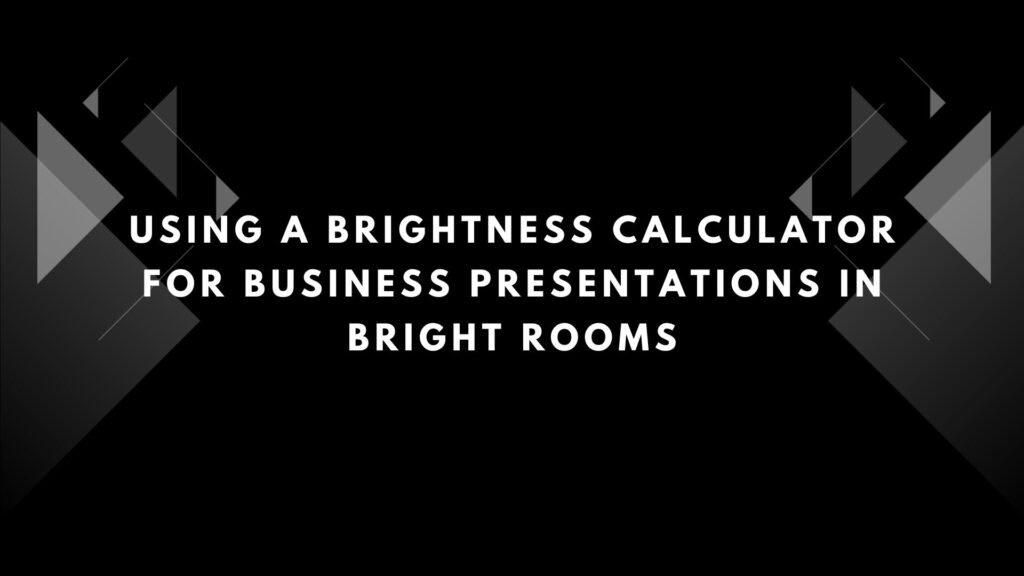When it comes to business presentations, your projector setup can make or break your audience’s experience. Whether you’re pitching a new idea to stakeholders, presenting quarterly results, or training a large team, visibility is key. In many business settings, these presentations take place in bright rooms filled with natural light, overhead fixtures, and glass walls—conditions that demand the right projection brightness for your message to land effectively.
So how do you ensure your visuals stay crisp and readable in a well-lit space? The answer lies in smart planning and one vital tool: a projector brightness calculator. More specifically, following a projector brightness calculator guide ensures you match the projector’s output to your presentation environment. In this blog, we’ll explore how brightness calculators work and how they can help you set up a powerful, visible, and professional presentation system—even in the brightest rooms.
Why Brightness Matters in Business Settings
Unlike home theaters or dark training rooms, business environments are often filled with ambient light. These conditions include:
-
Open office layouts with ceiling lights
-
Conference rooms with large windows
-
Glass partitions allowing natural light
-
Bright digital signage nearby
-
Whiteboard walls that reflect light
In such settings, low-lumen projectors quickly fall short. The image becomes washed out, colors are dull, and text is hard to read. And when your audience can’t clearly see your visuals, your message loses impact. This is why brightness is a non-negotiable factor in projector planning for business presentations.
What Is a Brightness Calculator?
A brightness calculator is a tool that estimates how many lumens your projector should have based on your specific environment. These tools take into account:
-
Screen size
-
Screen gain
-
Ambient lighting
-
Desired brightness level (measured in foot-lamberts)
With a few simple inputs, the calculator delivers a recommended brightness range. This is particularly helpful in business rooms where lighting conditions are not ideal for projection. Following a projector brightness calculator guide allows professionals to plan effectively without overspending on brightness they don’t need or falling short of what’s required.
Key Variables to Input
Let’s look at the main factors that a projector brightness calculator uses to make its recommendation:
1. Screen Size
The larger the screen, the more lumens you need. Screen size is usually given as a diagonal measurement, but brightness planning requires screen area in square feet or meters.
Example:
A 120-inch diagonal screen with a 16:9 ratio has a width of about 105 inches and a height of about 59 inches. That’s about 43 square feet of screen area.
2. Room Lighting
For bright business rooms, most calculators recommend aiming for 50 to 80 foot-lamberts (fL). The more light in the room, the higher the required brightness.
3. Screen Gain
Screen gain is a measure of how much light is reflected by the screen. A gain of 1.0 reflects light evenly. High-gain screens (like 1.3 or 1.5) reflect more light back toward the audience, effectively increasing brightness. Lower-gain or matte surfaces reflect less light and require a brighter projector.
4. Desired Viewing Quality
For business applications, you typically want crisp graphics, readable text, and vibrant colors. That means choosing a brightness level that combats glare while preserving contrast and color accuracy.
How to Use a Brightness Calculator: A Step-by-Step Guide
Let’s walk through an example using a standard office setting:
-
Room type: Bright conference room with overhead lighting
-
Screen size: 120-inch diagonal, 16:9 aspect ratio
-
Screen gain: 1.0
-
Ambient light: High
-
Target foot-lamberts: 60
Using the basic brightness formula:
Lumens = Screen Area × Target Foot-Lamberts × Screen Gain
Screen Area = approx. 43 sq ft
Target = 60 fL
Gain = 1.0
Lumens = 43 × 60 × 1.0 = 2,580 lumens
So, your projector should output at least 2,600 lumens for that setup. If your room is especially bright or if you’re using a screen with less than 1.0 gain, you may need 3,000–4,000 lumens for reliable performance.
Benefits of Using a Brightness Calculator in Business Environments
1. No More Guesswork
The calculator gives you a data-backed answer. Instead of guessing how many lumens you need, you can plan with precision.
2. Improved Presentation Quality
With the right brightness level, your images are crisp, text is readable, and your presentation looks professional—no matter the lighting.
3. Saves Money
You avoid overspending on ultra-bright projectors when a moderately bright model would suffice for your room and screen type.
4. Better Planning for AV Teams
If you’re managing multiple conference rooms or standardizing AV systems across offices, using a projector brightness calculator guide ensures consistency and performance across the board.
Tips for Optimizing Brightness in Bright Rooms
-
Use high-gain or ambient light rejecting (ALR) screens to improve image visibility
-
Control lighting where possible with blinds or dimmable fixtures
-
Position the screen away from windows and reflective surfaces
-
Avoid small font sizes and low-contrast color schemes in presentations
-
Use laser or LED projectors with high lumen output for large rooms
Top Brightness Calculator Tools to Try
Here are a few reliable projector brightness calculators:
-
Projector Central Brightness Calculator
-
Epson Projection Tool
-
ViewSonic Brightness Estimator
-
XTEN-AV for commercial AV designs
-
BenQ Projection Calculator
Each one follows similar math but may offer unique features for commercial or residential use.
Read more: https://backlinksseo.in/how-to-match-your-projectors-brightness-with-screen-type-and-size/
Final Thoughts
Presenting in a bright room doesn’t have to mean sacrificing quality. With the right tools and planning, your projector can deliver powerful visuals that shine—even under intense lighting. Using a projector brightness calculator guide helps you design a system that’s tailored to your space, ensuring your presentations remain impactful, readable, and professional.
Whether you’re outfitting one conference room or a network of training spaces, take a few minutes to calculate your brightness needs before you choose your projector. Your audience, and your message, deserve nothing less.
Also read: https://guest-post.org/adapting-your-contract-proposal-based-on-client-personality-types/











































